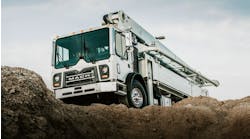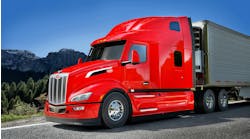UPS has placed an order for seven hydraulic hybrid vehicles (HHV), becoming the first delivery company to place an order for an emerging technology developed by the Environmental Protection Agency (EPA).
According to UPS, road tests of the vehicle conducted two years ago in Detroit showed 45 to 50% improvement in fuel economy and a 30% reduction in CO2 compared to its conventional diesel delivery trucks. The EPA said the technology should perform equally well in applications such as shuttle and transit buses and refuse trucks.
"There is no question that hydraulic hybrids, although little known to the public, are ready for prime time use on the streets of America," said David Abney, UPS COO. "We are not declaring hydraulic hybrids a panacea for our energy woes, but this technology certainly is as promising as anything we've seen to date."
Joined at a press conference in Atlanta by representatives from the EPA, Eaton Corp. and Navistar, UPS said it will deploy the first two HHV vehicles in Minneapolis in the first quarter of 2009, with the additional five HHV’s to be deployed later in 2009 and 2010. Eaton, which helped develop the hydraulic hybrid power system, will monitor the vehicle’s fuel economy performance and emissions in the Minneapolis area.
"We continue to be pleased with the progress and potential of the hydraulic hybrid system," Eaton chairman & CEO Alexander M. Cutler said at the press conference. "The market for this technology is truly global, and it can provide significant improvements in fuel economy and emission reductions for trucks, buses and off-road vehicles of many shapes and sizes."
The HHV combines a high-efficiency diesel engine with a hydraulic propulsion system that replaces a conventional drivetrain and transmission, using hydraulic pumps and storage tanks to capture and store energy, UPS said. As the diesel engine is used to periodically recharge pressure in the hydraulic propulsion system, fuel economy is increased because vehicle braking energy is recovered, the engine is operated more efficiently and the engine is capable of shutting off when stopped or decelerating.
"EPA and our partners are not just delivering packages with these UPS trucks, we're delivering environmental benefits to the American people," said EPA Administrator Stephen L. Johnson. "With this investment in fuel-efficient technology, UPS is doing what is good for our environment, good for our economy, and good for our nation's energy security."
The hydraulic hybrid vehicle was first introduced at the 2004 Society of Automotive (SAE) World Congress. The EPA said that the added costs of the hybrid components—which include a battery pack, electric generator/motor, power electronics, and one or more hydraulic pump/motors—can be recouped in less than three years due to lower fuel and brake maintenance costs.
With the addition of the hydraulic hybrid, UPS’s current “green fleet” will total more than 2,100 vehicles, including all-electric, hybrid electric, compressed natural gas (CNG), liquefied natural gas (LNG) and propane-powered trucks. The HHV vehicle order follows the May 2008 purchase of 500 hybrid electric and CNG vehicles and the April 2008 deployment of 167 CNG vehicles in seven North American metro areas.
View more Fleet Management news and other trucking industry news from Fleet Owner.



